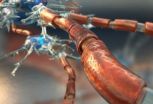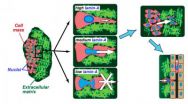(Press-News.org) Temperature, not snowfall, has been driving the fluctuating size of Peru's Quelccaya Ice Cap, whose dramatic shrinkage in recent decades has made it a symbol for global climate change, a Dartmouth-led study shows.
The findings support many scientists' suspicions that tropical glaciers are rapidly shrinking because of a warming climate, and will help scientists to better understand the natural variability of past and modern climate and to refine models that predict tropical glaciers' response to future climate change.
The study appears in the journal Geology. A PDF is available on request.
Dartmouth glacial geomorphologist Meredith Kelly and her lab team used field mapping combined with the beryllium-10 surface exposure dating method and ice cores obtained by Ohio State University paleoclimatologist Lonnie Thompson to examine how the Quelccaya Ice Cap has expanded and retreated over the past millennium. It is the first time that a record of past glacial extents has been compared directly with an annually dated ice core record from the same ice mass.
During the last millennium, a significant cooling event known as the Little Ice Age occurred, but scientists don't know what caused the cooling or its geographic extent. The Dartmouth-led team determined beryllium-10 ages of moraines – or glacier sediments -- that mark the past positions of Qori Kalis, an outlet glacier that has been monitored by Thompson since he first visited Quelccaya in the early 1960s. The Quelccaya Ice Cap, the largest ice mass in the tropics, sits 18,000 feet above sea level in the Peruvian Andes.
The results show that Qori Kalis advanced to its late Holocene maximum position prior to 520 years ago and subsequently retreated with only minor re-advances since that time. The comparison of the moraine record with the ice core record suggests that temperature was the driving force of glacial expansion and retreat, says Justin Stroup, lead author and a PhD candidate in Dartmouth's Department of Earth Sciences.
"This is an important result since there has been debate about the causes of recent tropical glacial recession – for example, whether it is due to temperature, precipitation, humidity, solar irradiance or other factors," says Kelly, a co-author of the study. "This result agrees with Professor Thompson's earlier suggestions that these tropical glaciers are shrinking very rapidly today because of a warming climate."
Furthermore, the ebbs and flows of other glaciers in tropical South America are similar to the Qori Kalis extents, indicating a regionally consistent pattern of past climate conditions. On a global scale, the results suggest that glaciers were larger than present and depositing moraines in both northern and southern hemispheres at about the same time, indicating that the climate mechanisms which caused the late Holocene cooling likely influenced a globally synchronous pattern of cooling.
INFORMATION:
The research, which was funded by National Science Foundation, includes Dartmouth College, the University of Cincinnati and Penn State University.
Available to comment are Justin Stroup at Justin.S.Stroup.GR@dartmouth.edu and Professor Meredith Kelly at Meredith.A.Kelly@dartmouth.edu
Broadcast studios: Dartmouth has TV and radio studios available for interviews. For more information, visit: http://www.dartmouth.edu/~opa/radio-tv-studios/
Dartmouth-led research shows temperature, not snowfall, driving tropical glacier size
2014-02-25
ELSE PRESS RELEASES FROM THIS DATE:
PFC exposure may spark metabolic changes in overweight children
2014-02-25
Washington, DC—Overweight children who were exposed to higher levels of perfluorinated chemicals tended to show early signs of developing the metabolic syndrome, according to a new study published in The Endocrine Society's Journal of Clinical Endocrinology & Metabolism.
The term metabolic syndrome describes a cluster of risk factors that increase the chances of developing heart disease, stroke and diabetes. The study is the first to find changing metabolic markers in children were associated with exposure to perfluorinated chemicals (PFCs), common industrial chemicals ...
Vitamin D deficiency may compromise immune function
2014-02-25
Washington, DC—Older individuals who are vitamin D deficient also tend to have compromised immune function, according to new research accepted for publication in the Endocrine Society's Journal of Clinical Endocrinology & Metabolism (JCEM).
Vitamin D plays an important role in helping the body absorb calcium needed for healthy bones. The skin naturally produces vitamin D when it is exposed to sunlight. People also obtain smaller amounts of the vitamin through foods, such as milk fortified with vitamin D. More than 1 billion people worldwide are estimated to have deficient ...
Tissue repair drug helps heal diabetic foot ulcers
2014-02-25
Washington, DC—Patients were twice as likely to have a diabetic foot ulcer heal within eight weeks when they were treated with a tissue repair drug versus a placebo, according to new research accepted for publication in the Endocrine Society's Journal of Clinical Endocrinology & Metabolism (JCEM).
Foot ulcers are a common complication from diabetes than can lead to hospitalization and lower limb amputation. In 2006, about 65,700 non-traumatic lower-limb amputations were performed in people with diabetes, according to the Centers for Disease Control and Prevention. Up ...
New study presents evidence that blood pressure should be measured in both arms
2014-02-25
Philadelphia, PA, February 25, 2014 – As heart disease continues to be one of the leading causes of death in the United States, practitioners and patients alike are looking for ways to cut risk factors and identify new clues to assist with early detection. New research published in the March issue of The American Journal of Medicine suggests that there is an association between a difference in interarm systolic blood pressure and a significant increased risk for future cardiovascular events, leading researchers to recommend expanded clinical use of interarm blood pressure ...
Ecotoxicity: All clear for silver nanoparticles?
2014-02-25
It has long been known that, in the form of free ions, silver particles can be highly toxic to aquatic organisms. Yet to this day, there is a lack of detailed knowledge about the doses required to trigger a response and how the organisms deal with this kind of stress. To learn more about the cellular processes that occur in the cells, scientists from the Aquatic Research Institute, Eawag, subjected algae to a range of silver concentrations.
In the past, silver mostly found its way into the environment in the vicinity of silver mines or via wastewater emanating from the ...
Georgia Tech project ensures 'what you see is what you send'
2014-02-25
Imagine a user who intends to send $2 to a friend through PayPal. Embedded malware in the user's laptop, however, converts the $2 transaction into a $2,000 transfer to the account of the malware author instead.
Researchers at Georgia Tech have created a prototype software, Gyrus, that takes extra steps to prevent malware from sending spam emails and instant messages, and blocking unauthorized commands such as money transfers.
Current protection programs might recognize the original user's intent to send email, transfer money or engage in other transactions, but cannot ...
Unhealthy attachments
2014-02-25
(Santa Barbara, Calif.) — Using the surface forces apparatus and an atomic force microscope, researchers at UC Santa Barbara have taken a molecular approach to myelin membrane interactions, leading to insights into demyelinating diseases, such as multiple sclerosis. Their research is published in the Proceedings of the National Academy of the Sciences.
For a healthy nervous system, axons — the long projections of our nerve cells that run throughout our bodies — must be properly insulated. Much like conventional power cords need electrical insulators around the conducting ...
Penn researchers show nuclear stiffness keeps stem cells and cancer cells in place
2014-02-25
Adult stem cells and cancer cells have many things in common, including an ability to migrate through tiny gaps in tissue. Both types of cells also experience a trade-off when it comes to this ability; having a flexible nucleus makes migration easier but is worse at protecting the nucleus' DNA compared to a stiffer nucleus. Nuclear proteins that regulate nuclear stiffness are therefore thought to control processes as diverse as tissue repair and tumor growth.
In a study published in the Journal of Cell Biology, researchers at the University of Pennsylvania have shown ...
Climate engineering: Minor potential, major side effects
2014-02-25
Despite international agreements on climate protection and political declarations of intent, global greenhouse gas emissions have not decreased. On the contrary, they continue to increase. With a growing world population and significant industrialization in emerging markets such as India and China the emission trend reversal necessary to limit global warming seems to be unlikely. Therefore, large-scale methods to artificially slow down global warming are increasingly being discussed. They include proposals to fertilize the oceans, so that stimulated plankton can remove ...
Breast-feeding benefits appear to be overstated, according to study of siblings
2014-02-25
COLUMBUS, Ohio – A new study comparing siblings who were fed differently during infancy suggests that breast-feeding might be no more beneficial than bottle-feeding for 10 of 11 long-term health and well-being outcomes in children age 4 to 14.
The outlier was asthma, which was associated more with breast-feeding than with bottle-feeding.
The study also included an analysis of outcomes across families of different races and socioeconomic circumstances for comparison purposes, and those results matched other studies suggesting that breast-feeding's benefits to children ...


